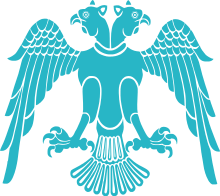Oksoko

Oksoko (Turkish: Öksökö), also known as Zuzulo (Turkish: Züzülö), is a double-headed eagle in Turkish mythology related to Burkut the eagle God.
The Oksoko bird brings down lightning from the Heavens to Earth with rain which in return creates human bodies and humans themselves. This lightning carries Oz (Turkish: Öz). Oz is the human soul. This energy carrying the will of Tengri with a purpose and desire. In fact Oksoko consists of two birds, Toghrul and Kongrul (Tuğrul and Konrul), and sometimes Semruk and Merkut, and it is their combined form.[1] Oksoko symbolizes luck and happiness similar to the Huma bird.[2]
In Turkey, the symbol is being used in various areas like the police, schools, vehicles, football clubs and municipalities.
Origins
The two-headed eagle as the Oksoko can be found in the archaeological remains of the Sumerian civilization. Cylindric seals discovered in Boghazkoy, an old Hittite capital in modern-day Turkey. It originally dates from 3800 BC, and was the Sumerian symbol for the god of Lagash.
By the Seljuks
Oksoko was Emblem of the Seljuk Turk dynasty and the Great Seljuk Empire. The double-headed eagle became the standard of the Seljuks with the crowning of Tughril Beg (Tuğrul/Toğrul means "Falcon") as "King of the East and the West" and was much used afterwards.
Toghrul and Konqrul
They symbolizes Kuyash (Sun) and Yalchuk (Moon) or masculine and feminine, also Yin-Yang. Turul and Konrul are twin birds in Turkish mythology. They known also Buğdayık and Kumayık or Semrük and Kerkes. They roosted in Tree of Life, which stands in the middle of the world. The relationship between the Turul and Konrul is extremely close.
Etymology
The word "Ögsöh" means in Mongolian language to rise, to climb, go up[3]...
See also
References
- ↑ Türk Söylence Sözlüğü (Turkish Mythological Dictionary), Deniz Karakurt, (OTRS: CC BY-SA 3.0)
- ↑ Türk Mitolojisi Ansiklopedik Sözlük, Celal Beydili, Yurt Yayınevi
- ↑ Mongolian Dictionary, Andras Rajki ("ögsöh")
External links
- Mythical Creatures, "Turul"
- Öksökö-Semrük
- Turkish Mythology and The Ethernal Sky
- Öksökö. Encyclopedia of Fictional Personalities (Russian)
- Çift Başlı Kartal (Turkish)